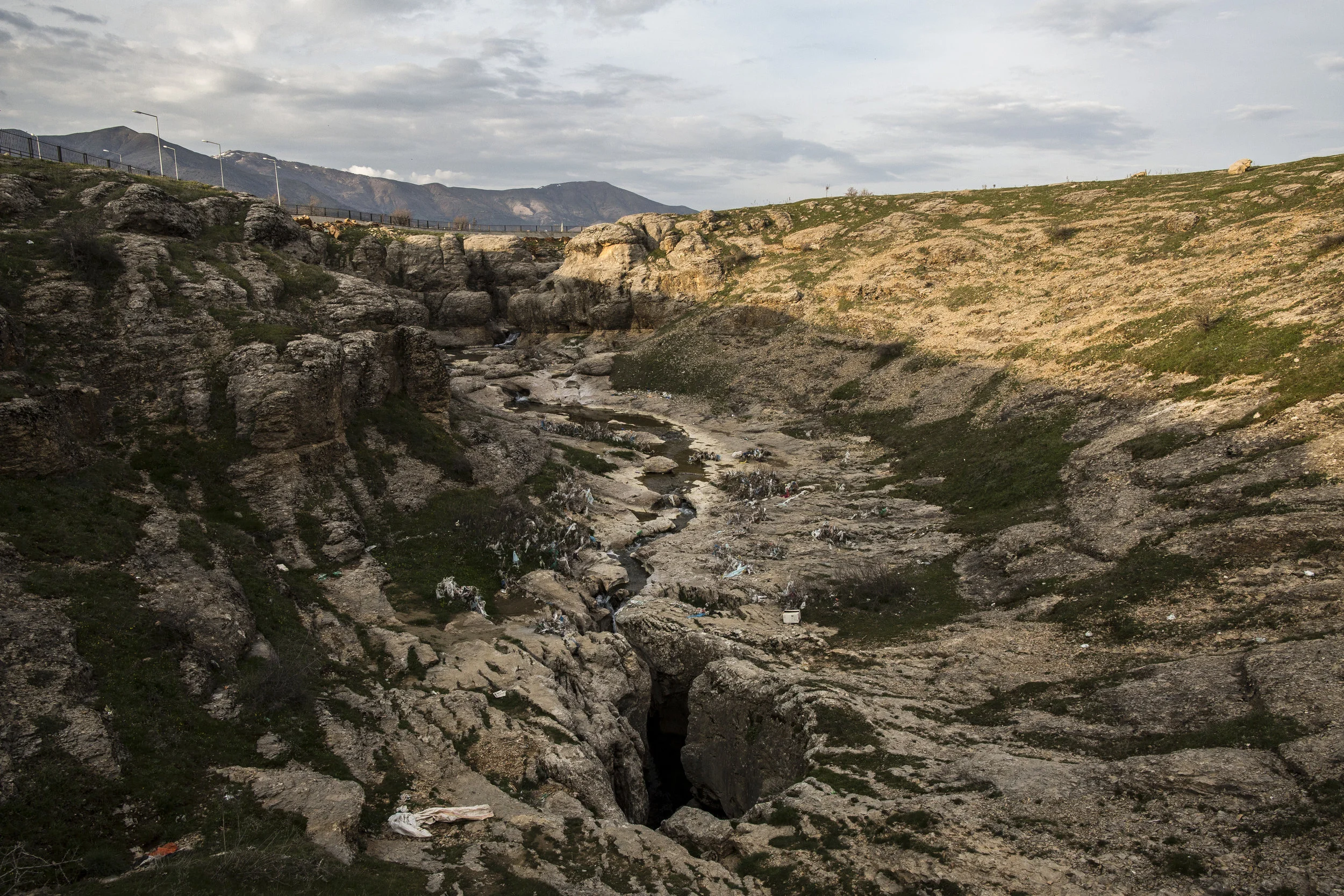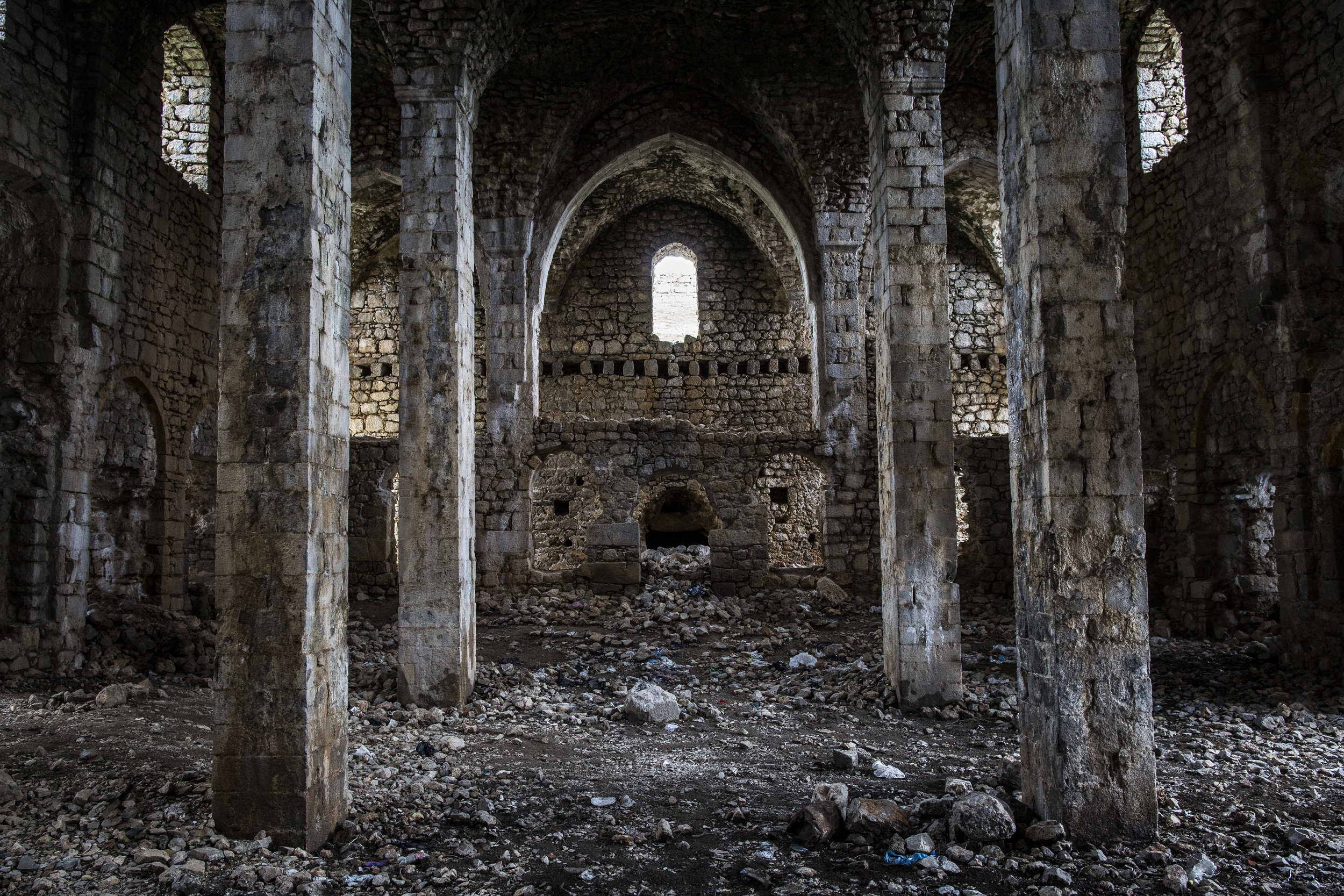











3/30/2015 Antelias, Lebanon
The skulls of victims of the 1915 Armenian Genocide, perpetrated by the Ottoman Empire during the First World War, are displayed in a monolithic glass column at a small memorial chapel located on the grounds of the Armenian Catholicosate of Cilicia, located in Antelias, Lebanon. The remains were brought to Lebanon in the 1930's from Deir ez-Zor in Syria according to church officials. The memorial chapel and church are constructed on grounds that originally hosted an orphanage established by the American Committee for Relief in the Near East in 1922, for Armenian children who lost their parents in the genocide.

3/18/2015 Çüngüş, Turkey
A small stream flows into the Dudan cave, pictured here, which drops several hundred feet into darkness. It was here that the Armenian residents of the village of Çüngüş are said to have been thrown, after being led there by Ottoman Gendarmes and local Kurdish paramilitaries. Historical accounts say that the men were bayonetted first, or killed with axes, before being thrown into the hole. The women and children followed, first stripped of their clothing and belongings before having their throats slit. Some jumped with their children, apparently avoiding the humiliation of giving up their belongings.

4/2/2015 Istanbul, Turkey
Turkish-Armenian women searched for the graves of relatives in the Armenian Cemetery in the Sisli district of Istanbul, on the Monday following easter Sunday. The Cemetery is home to the remains of many prominent Turkish-Armenians, including Daniel Varoujan, a prominent Armenian poet, who was arrested, brutally tortured and murdered during the Armenian Genocide in 1915.

4/5/2015 Diyarbakir, Turkey
An Armenian Chrsitian woman attended the easter mass to at the restored Surp Giragos church in Diyarbakir, Turkey. The church, which was shuttered during the Armenian Genocide, and was reopened after extensive renovation in 2011, with support from the local predominantly Kurdish municipal government as well as donations from the Armenian diaspora.
In 2016, the Church was heavily damaged during fighting between the Turkish Military and Armed Kurdish factions. Before it’s modern destruction, regular services at the church are not held, and the annual easter service, which attracts visitors from around Turkey, as well as abroad, is officiated by priests and clergy who fly in for the ceremony. Many of the Armenians who come to the easter service are Muslims—the descendants of grandparents who survived the massacres, many as children, and were taken in by Muslim Turkish families. While many of Turkey's ethnic Armenians have begun to reclaim their ethnic identity, very few have converted to Christianity.

4/4/2015 Istanbul, Turkey
People ate lunch in the shadow of the Hyderpasa train station on the Asian side of Istanbul, seen in the background here. Over 200 Armenian intellectuals were deported aboard trains that left Hyderpasa for Ankara, following the first arrests of Armenian Intellectuals in Constantinople by Ottoman authorities, known as "Red Sunday," April 24, 1915. The number of Armenians deported from Istanbul would climb steadily in the ensuing weeks, and while the official policy was one of relocation, many of those arrested would eventually be killed.

4/8/2015 The Ani Ruins, Turkey
Known as the City of 1001 Churches, Ani was once the capital of a midivil Armenian kingdom that stretched from eastern Turkey into modern day Armenia. Today, the Ruins of Ani lie just on the Turkish side of the border. Captured in 1918 by Ottoman Empire forces following the Russian Empire's descent into revolution, it was looted and partially destroyed. Later, in 1921, when the new Turkish State was fighting it's way through the region once again against a newly independent Armenia, Turkish forces were ordered to wipe it from the face of the earth. The name Ani has become a popular name among members of the Armenian diaspora, many say in the spirit of remembering their ancestral capital, and what many Armenians view as it's unjust occupation by Turkey.
Ani remains a point of contention between Turkey and Armenians worldwide today, who accuse the Turkish government of intentional neglect of part of their ethnic and national heritage. While open to the public, it was long inside a declared Turkish Military zone. A number of organizations list Ani as being one of the most endangered historical sites in the world. Turkish media have recently reported that the Turkish government will push for Ani to finally be recognized as a UNESCO World Heritage Site in 2016.

4/2/2015 Vakifili Köyu, Turkey
Turkish-Armenian residents of Vakifili Köyu, the last Armenian village in Turkey, played cards at the small tea house in the center of their village, where roughly 130 Armenian's are left of what was once a large network of seven villages.
The village of Vakifili Köyu is currently the only Armenian village left in Turkey. Located on the Mediterranean coast within site of Turkey's border with Syria, the approximately 130 remaining residents are the descendants of the Armenians from the area who resisted the Ottoman Forces' during the Armenian Genocide of 1915. Once part of a network of seven Armenian villages in the area, the Armenians of Vakifili Köyu were the only ones to return after being evacuated by French forces, returning once the French occupied the area, then part of Syria, in 1918 following the end of the First World War.

3/18/2015 Çüngüş , Turkey
The gutted and abandoned interior of an Armenian monastery in Çüngüş, Turkey, north of Diyarbakir, which, according to locals, is now used to house livestock.
During the genocide, the local Armenian population of Çüngüş is said to have been deceived into marching out of town, under the guise of deportation, whereupon thousands of men were massacred and thrown into a cave opening by Kurdish Ottoman Forces. The village is now predominantly Kurdish, and some locals believe that the crimes of their ancestors have cursed the land.

4/9/2015 Akdamar Island, Turkey
The Church of the Holy Cross, located on Akdamar Island in Lake Van. During the Armenian Genocide, in 1915, Lake Van was a major center for the region's Armenian population, where they made up much of the population along it's shores.
In April, 1915, the church's monks were slaughtered and the church looted and partially destroyed by Ottoman Forces as part of a wider campaign against the Armenian population of the region. It's facade was used as a shooting range, according to Turkey's leading Armenian weekly paper, Agos, and was slated for demolition in 1951 before being saved, according to a Turkish writer who visited at the time.

4/11/2015 Istanbul, Turkey
Groups of tourists passed in front of the Turkish Islamic Arts Museum, located in Sultanahmet Square, which in April of 1915 was used as a "prison house" for Armenian intellectuals and notables who were detained as part of the first wave of what would ultimately be the deportation and murder of much of Istanbul's Armenian intellectual class.

4/9/2015 Van, Turkey
A Turkish couple looked across the lake from a derelict pier along the shores of Lake Van in the town of Erçis. It was recorded in 1916 by British Historians that one of the initial massacres took place here on April 19, 1915 after Tax collectors backed by Ottoman gendarmes traveled to Erçis several days earlier to collect tax, calculated based on the number of sheep Armenian grazers possessed. Disagreement led to violence, resulting in the massacre of 2,500 Armenian residents of Erçis at the hands of the Ottomans.
The city of Van, located on the large inland lake that bears the same name, was one of the only centers of resistance to the Armenian Genocide, perpetrated by the Ottoman Empire during the First World War, which killed an estimated 1-1.5 million Armenians through the use of mass killings and deportations that were characterized by brutal death marches into the Syrian and Iraqi deserts. Despite there being overwhelming evidence from sources on the ground at the time, including diplomats, military officials, and news outlets, including the New York Times, Turkey still maintains a firm stance of denial that a genocide took place.